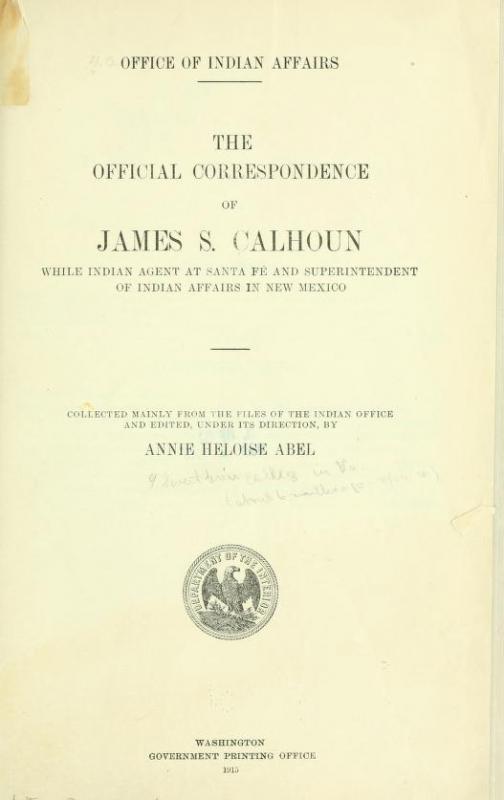1.6 Excerpts from Correspondence, John Greiner, May 19, 1852
Acting Superintendent of Indian Affairs for New Mexico Territory, John Greiner, conveys to Luke Lea, U.S. Commissioner of Indian Affairs, Luján’s version of events, May 19, 1852.
Document Introduction
Following their trial, Luján and his companions endured an arduous return trek to New Mexico on foot in the middle of winter. It took them nearly two months to make the journey from Salt Lake City to Abiqui. Along the way they “suffered a great deal from being caught in the snows in the Mountains.” Upon his return, Luján made federal authorities in New Mexico aware of what had happened in Utah Territory and offered them his version of events. He traveled to Santa Fe and on April 30, 1852, he met with John Greiner, Acting Superintendent of Indian Affairs for New Mexico Territory. At the time, Governor James S. Calhoun was suffering from ill health and so Greiner served as Indian agent in his stead. Greiner recorded in his journal that Pedro Leon met with him and gave “an account of his trip to Salt Lake, and his treatment by the Mormons.” Greiner noted that Leon was “making out [a] special report on this subject.”[1] On May 19, Greiner then passed the information he learned from Luján on to Luke Lea, U. S. Commissioner of Indian Affairs in Washington D.C.[2]
According to Greiner, Luján came to believe that he was denied a license to trade in Utah Territory because “he was not a Mormon.” Luján also believed that the Indian children who were confiscated from him at the time of his arrest “were sold to the Mormons as servants, by the Mormon authorities” after the trial ended. He had no complaint to make against “Governor Young” whom he said “treated the whole party with the greatest kindness.” Nonetheless Greiner shaped his assessment of the incident in a way that was calculated to defend to Commissioner Lea the practice of Indian servitude then taking place in New Mexico Territory. “As soon as a Payutah[3] child is brought into a Mexican family, he is taught the Mexican language—the Lords prayer, baptized—considered a Christian and adopted,” Greiner explained. “The Mexican laws know no slavery, and any person offering to sell an Indian, after being baptized, not only violates the laws of the land—but the laws of the Church.”[4] It was clearly an idealized assessment of the Indian servitude taking place in New Mexico.
Those in Utah Territory also idealized the form of servitude that they practiced. They believed that when Mormon settlers bought children from Ute traders they were in fact “purchasing them into freedom, instead of slavery.” Brigham Young, in fact, claimed that the Mormon version of the practice was “not the low, servile drudgery of Mexican slavery” where they were doomed to be “raised among beings scarcely superior to themselves.” Rather, in Mormon hands they would be raised in a “humane and benevolent society.”[5] In both cases, Greiner and Young attempted to describe their respective versions of Indian servitude as morally superior to the practices taking place elsewhere and to distinguish it from slavery. Of course what the Native Americans who were bought and sold actually thought about the enlightened nature of both societies is sorely missing from Young and Greiner’s assessments.
[1] John Greiner, “The Journal of John Greiner,” ed. by Annie Heloise Abel, Old Santa Fe: A Magazine of History, Archaeology, Genealogy and Biography, vol. 3, no. 11 (July 1916), 201.
[2] John Greiner, Santa Fe, New Mexico, to Luke Lea, Washington D.C., 19 May 1852, in Official Correspondence of James S. Calhoun while Indian Agent at Santa Fe and Superintendent of Indian Affairs in New Mexico, ed. Annie Heloise Abel (Washington, D.C.: Government Printing Office, 1915), 536-537.
[3] Southern Paiute.
[4] The Catholic Church.
[5] Journals of the House of Representatives, Council, and Joint Sessions, 104-110; “Governor’s Message,” Deseret News (Salt Lake City) vol. 2, no. 5, 10 January 1852, 18.


